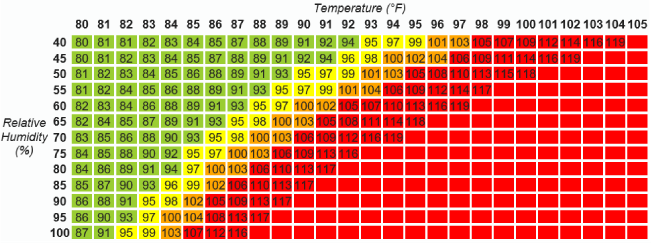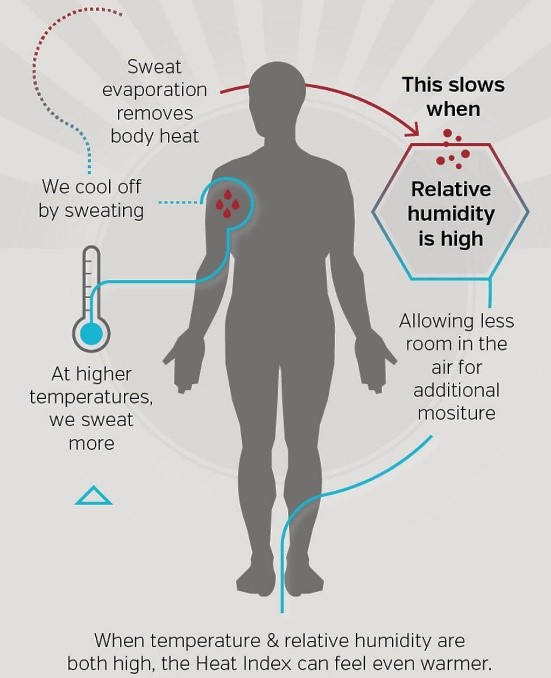heat index calculator
HEAT INDEX POLICY
When the Heat Index meets or exceeds 70°F it is recommended that all schools provide at any practice or event, a method for rapidly cooling athletes experiencing heat illness. Approved methods include ice water immersion or tarp assisted cooling with oscillation (TACO).
Schools shall monitor the heat index for their geographic area prior to practices. Outlined below are the steps that each member school shall take in order to implement this policy.
NOTE: This policy applies to all WIAA sanctioned sports and activities in all seasons. Indoor activities where air conditioning is available are not bound by this policy.
- DESIGNATE: Schools shall designate someone who will take the necessary steps to determine and record the heat index for your geographic area within one hour of the start of each team’s practice and events. This is only necessary on days when the forecasted heat index is 85°F or higher. Depending on practice and event schedules, it is possible that the designated person will have to record the Heat Index multiple times on the same day.
- CALCULATE: Within one hour of each team’s practice on days when the forecasted heat index is 85°F or higher, the designated person shall utilize the WIAA Heat Index Calculator to determine the actual heat index.
- RECORD: If the actual heat index is 85°F or higher, the designated person shall record it using the WIAA Heat Index Record or by printing out a copy to be kept at the school for inspection at the request of the WIAA. A separate record shall be kept for each sport at each level. Practice modification, as necessary, shall also be recorded. If the actual heat index is less than 85°F, no action is needed.
- ACT: If the actual heat index is 95°F or higher, activity should be altered and/or eliminated using the following guidelines:
WIAA Recommendation: Stop all outside activity in practice and/or play and stop all inside activity if air conditioning is unavailable.
WIAA Recommendation: Postpone practice to later in the day.
- Maximum of 4 hours of practice per day.
- Practice length a maximum of 2 hours, one practice shall be during a time of day with a lower heat index.
- Mandatory 3-hour recovery period between practices.
- Alter uniform by removing items if possible – allow for changes to dry t-shirts and shorts.
- Contact sports and activities with additional equipment – players are restricted to helmets, shoulder pads and shorts during practice. Other possible equipment removed if not involved in contact or necessary for safety.
- Reduce time of planned outside activity as well as indoor activity if air conditioning is unavailable.
- Provide unlimited amounts of water.
- Water shall always be available and athletes should be able to take in as much water as they desire.
- Watch/monitor athletes for necessary action.
WIAA Recommendation: Consider postponing practice to later in the day.
- Maximum of 4 hours of practice per day.
- Practice length a maximum of 2 hours.
- Mandatory 3-hour recovery period between practices.
- Contact sports and activities with additional equipment – helmets and other possible equipment removed if not involved in contact or necessary for safety.
- Provide unlimited amounts of water.
- Water shall always be available and athletes should be able to take in as much water as they desire.
- Watch/monitor athletes for necessary action.
- Maximum of 5 hours of practice per day in divided sessions.
- Provide unlimited amounts of water.
- Water should always be available and athletes should be able to take in as much water as they desire.
- Watch/monitor athletes for necessary action.
- Maximum of 5 hours of practice per day in divided sessions.
- Provide unlimited amounts of water.
- Water shall always be available and athletes should be able to take in as much water as they desire.
CALCULATION DETAILS
A heat index is an index that combines air temperature and relative humidity in an attempt to determine the human-perceived equivalent temperature; “how hot it feels.” The result is also known as the “felt air temperature” or “apparent temperature.” For example, when the temperature is 90°F with very high humidity, the heat index can be about 106°F.
The human body normally cools itself by perspiration, or sweating. Heat is removed from the body by evaporation of that sweat. However, relative humidity reduces the evaporation rate because the higher vapor content of the surrounding air does not allow the maximum amount of evaporation from the body to occur.

Higher humidity results in a lower rate of heat removal from the body, hence the sensation of being overheated. This effect is subjective; however, studies have been performed to normalize heat index representation (ksi.uconn.edu).
The table above is a listing of the calculated heat index values which match the U.S. National Oceanic and Atmospheric Administration’s table. The colors correspond to WIAA’s categorization (NOTICE, CAUTION, WARNING, and DANGER).
Looking at the table, it is important to note that any temperature above 86°F will “feel” at least 86°F. Virtually every heat index will be at least the current temperature, if not hotter.
![]()
The WIAA website uses a custom script to calculate a given heat index and forecasted heat index for a given location (i.e. city name or ZIP code). This is accomplished via a weather API service through AccuWeather.
This resource allows us to plug in a specific location and get back a data packet with pertinent information to determine a heat index. Specifically, we extract the returned current temperature, relative humidity, and forecasted high temperature. Our custom calculator then takes those variables to get a current heat index and a forecasted “high heat index”. The calculator will then show WIAA recommendations in accordance with the WIAA practice model.
Two variables, temperature (T) and relative humidity (R), are necessary to calculate a heat index. Given a current temperature and a relative humidity, a heat index can be calculated easily using the following polynomial equation. The formula approximates the heat index in degrees Fahrenheit and conforms to the NOAA National Weather Service’s Heat Index Lookup Table.
![]()
This equation is the result of a multivariate fit (temperature ≥ 80°F and relative humidity ≥ 40%) to a model of the human body. This equation does not work with temperatures under 80°F nor a relative humidity under 40% (values outside of that range are assumed to be the given temperature; i.e. 96°F with relative humidity of 25% would yield a heat index of 96°F).

There are other website services out there that can report a heat index. Those sites (like NOAA’s heat index maps) provide a heat index forecast for a broad area and are updated less frequently that the weather service WIAA implements. Most weather providers rely on National Weather Service (NWS) observation stations that are primarily located at airports and military bases. Each state only has a handful of these stations. The entire state of New York has less than fifty such sites, for example. Their reports are only accurate and relevant in the immediate vicinity of the observation station and generally updated only once every hour.
The AccuWeather API service generates forecasts with Superior Accuracy™ harnessing the expert skills of the world’s leading meteorologists in tandem with the most robust database of forecast models, most advanced global forecast engine, proprietary patents, and comprehensive validation results pinpointed for every location on Earth. This allows the WIAA Heat Index Calculator to use data for geographically specific results and up-to-date information.
It is recommended that WIAA schools check their practice location’s heat index through the WIAA Heat Index Calculator, no other site. The heat index is categorized and suggested practice modifications are provided. This helps us ensure consistency and lends an easier approach for school administrators and coaches.
PRACTICE MODEL
WIAA Handbook: Executive Board Policies (Revised 2020)
Schools and students are required to adhere to the following practice model:
- Insert cooling tub requirements within specific sports sections or in a general area:
- When the Heat Index meets or exceeds 70°F it is recommended that all schools provide at any practice or event, a method for rapidly cooling athletes experiencing heat illness. Approved methods include ice water immersion or tarp assisted cooling with oscillation (TACO).
If you move practices inside the same restrictions apply unless the indoor facility is climate controlled.
Must apply to all sports.



